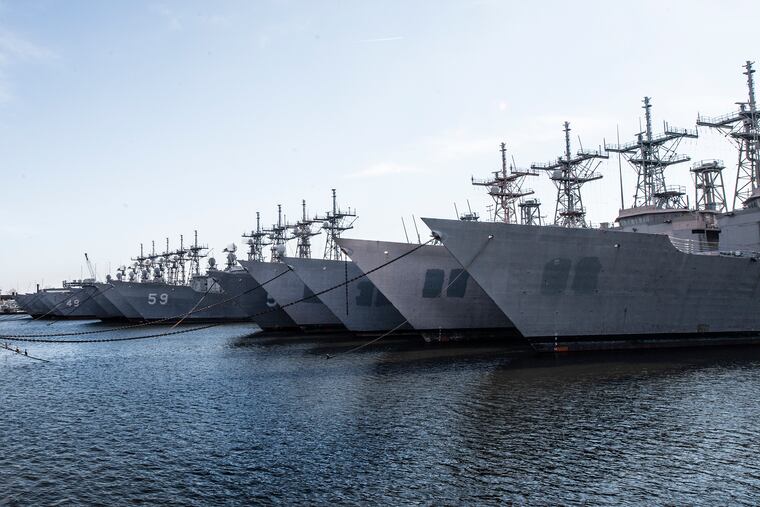Philadelphia’s ‘mothball fleet’: Uncertain future awaits ships docked at Navy Yard
Philadelphia is home to more than half of the Navy's decommissioned ships. They could be sold, used as museums, or scrapped.

It used to be called the "Mothball Fleet," a collection of Navy warships and other vessels that were no longer in use but could be reactivated if needed.
One of the former Mothball Fleet's best known ships was the New Jersey. After the battleship was decommissioned at the end of World War II, it was recommissioned and decommissioned three more times in the decades that followed — for the Korean War, the Vietnam War, and in the 1980s as part of President Ronald Reagan's initiative for a 600-ship Navy. It is now a museum and memorial on the Camden waterfront.
The term "Mothball Fleet" is seldom heard these days — perhaps because mothballs themselves are not widely used anymore — and decommissioned vessels are now stored at three Naval Inactive Ship Maintenance Facilities around the country.
One of them is at the former Philadelphia Naval Shipyard — or simply the Navy Yard, as everyone in Philly calls it — at the foot of Broad Street in South Philadelphia.
The sight of those ships prompted questions from a reader on Curious Philly, our question-and-response forum in which readers submit questions about their communities and our journalists report out the answers.
Of the 49 inactive ships nationwide, 31 are in Philly's Navy Yard. But there used to be even more.
The basin, visible from the Girard Point Bridge on I-95 near the stadium complex, held as many as 195 inactive ships in 1997. The Navy has been reducing the size of its inactive fleet, but still houses some at Pearl Harbor, Hawaii, and Bremerton, Wash., which is across Puget Sound from Seattle and is the home of the Camden-built aircraft carrier Kitty Hawk.
What sets Philadelphia apart besides its number of ships is that it is a fresh-water port, while Pearl Harbor and Bremerton have salt water. Fresh water is better for preventing rust.
>> READ MORE: Why is Philadelphia's Suburban Station in the heart of the city?
According to Naval Sea Systems Command, the vessels in Philadelphia range from a salvage ship, the Grapple, to the aircraft carrier John F. Kennedy, which, because of its size, is moored on the Delaware River, not in the basin.
The oldest vessel in the basin is the Barry (DD-933), a destroyer that was built at the Bath Iron Works in Maine, commissioned in 1956 and decommissoned in 1982. It was the third of four warships to be named after Commodore John Barry — whose name also adorns the bridge linking South Jersey and Chester — and took part in the blockade during the 1962 Cuban Missile Crisis as well as seeing action in Vietnam, earning two battle stars.
After it was decommissioned, it became a museum ship at the Washington Navy Yard on the Anacostia River in Washington, D.C. But faced with declining attendance and plans for construction of a bridge that would have trapped the destroyer in the Anacostia, the Navy in 2015 moved the Barry to Philadelphia to await scrapping.
Before joining the inactive fleet, the ships are stripped down, including removal of sensitive electronic equipment, and drained of fuel. They are then sealed, lightly air-conditioned, and electrically charged to deter rust.
Then the ships sit tight while officials figure out their fates.
Besides scrapping, the ships could be donated as memorial museums, used as targets, sunk to become artificial reefs, sold to foreign navies, or even recommissioned.
According to the Naval Vessel Register, eight of the ships in Philadelphia are designated for possible foreign sale, all of them guided missile frigates that entered service in the 1980s. One ship, the guided missile destroyer Charles F. Adams, is on hold for possible donation (an effort has been underway to make it a museum memorial in Jacksonville, Fla.). The Grapple is the only Philly vessel listed as in reserve.
As for the John F. Kennedy, which was retrofitted in Philadelphia in the early 1990s before the Naval Shipyard ceased operations and was stricken from the ships register in 2009, its future remains uncertain.
An effort to turn the Navy's last conventionally powered aircraft carrier into a museum in Rhode Island collapsed because the amount of work and money that would be needed to get it into shape. Chances are it will share the fate of its former Delaware River pier mate, the Forrestal. That aircraft carrier left Philadelphia in February 2014 to be scrapped in Brownsville, Texas.
A new John F. Kennedy, a nuclear-powered carrier, is under construction in Virginia with plans to commission it in 2020.
Correction: This story has been updated to reflect that the USS Barry in Philadelphia was the third warship named after Commodore John Barry, not the second.